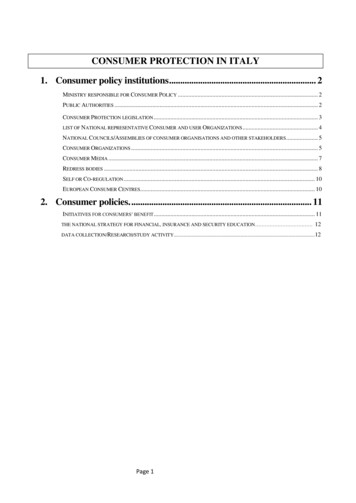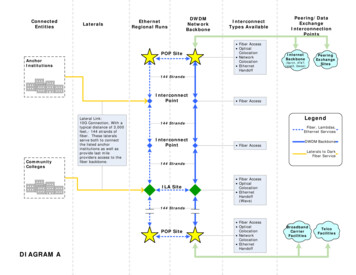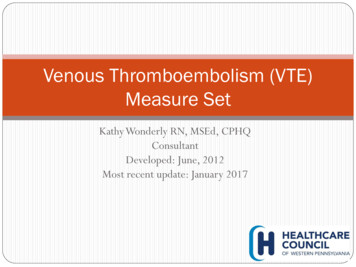
Transcription
2017 Consumer Healthcare Priorities Study:What Patients and Doctors Want from theHealth Care SystemCouncil of Accountable Physician Practices (CAPP)Focus Group Research Results225 South Lake Ave. Suite 300Pasadena, CA 91101Contact: Sophia Tripodes GomezT: 626-795-4880E: sophia@publicvalues.com
Study Purpose Methodology Results Conclusions & Recommendations
Builds on Previous CAPP Research In 2016, CAPP conducted a national survey of patients and doctors and found thatmost Americans are not receiving the kind of healthcare that many industry leadersbelieve delivers better patient outcomes at a lower cost. The 2016 study helped to identify the gaps between what experts believe patientsshould be getting from their healthcare and what they are actually receiving. But it did not address patient expectations and desires.
Purpose of the 2017 Study To understand what consumers want from their healthcare providers and to identify theattributes that matter most to them. To understand what physicians want for their patients, regardless of cost, and howthose priorities compare to what consumers think they need. The focus of the study was on the quality and delivery of healthcare services, not costor payment systems.
Study Purpose Methodology Results Conclusions & Recommendations
Methodology11 Focus GroupsConsumers and Primary Care PhysiciansWICONJ
MethodologyMillennialsGeneration XBoomersMedicarePrimaryPhysiciansTotalArapahoe County, CO111NA3Burlington County, NJ11113Milwaukee County, WI11113Total333211
Methodology All participants had health insurance and reflected a variety of health insurance plans andproviders Half were above median income and half below The study did not include Medicaid recipients All participants were English speakers Healthy individuals and those with chronic or complex medical conditions Parents and non-parents A total of 89 consumers and 18 physicians participated in the study
Ranking Methods Participants were each given set of 22 cards, each labeled with a different attribute, andasked to sort them in order of priority, with most important at the top of the stack. Attributes were later sorted into 7 clusters including the doctor-patient relationship,evidence-based medicine, coordinated care, prevention services, facilities, access, andtechnology.
Ranking Methods Conclusions about leading attributes were not based solely on the average ranking ofthe cluster and the number of participants who ranked each attribute very high or verylow, but also how strongly participants felt about a feature and why. The ranking exercise was designed to enrich the discussion. Tallies from the rankingexercise are useful and accurate for understanding the views of study participants, butis not a statistical sample.
Study Purpose Methodology Results: Healthcare Priorities Conclusions & Recommendations
Consumers: Attribute Clusters Ranked by PriorityTier 1PrioritiesTier 2PrioritiesTier 3Priorities Doctor/Patient Relationship Evidence-Based Medicine Care Coordination Facilities Access Technology Prevention Services
Consumers: Tier 1 PrioritiesPersonal Doctor-Patient Relationship Single most important hallmark of quality care. The majority of consumers, regardless of age or health status, want a doctor who isexperienced and knowledgeable, listens to their concerns, explains things clearly, andspends as much time as necessary. Most consumers who participated in the study ranked one or more of the physician relationattributes as one of their top six cards. Only two individuals ranked any of these attributesas their lowest priority (bottom three cards). On average, consumers ranked the doctor/patient cluster 5 from the list of 22 attributesincluding access, facilities, and technology.
Consumers: Tier 1 PrioritiesEvidence-Based Medicine Consumers expect that their medical treatment will be based on evidence and shared-decisionmaking. This cluster included the use of treatment based on proven methods, a doctor who stays up-to-datewith the current research, and a doctor who considers the patient’s treatment preferences. Consumers believe treatment based on proven methods and current research is even more importantthan a doctor’s willingness to consider a patients’ treatment preferences. Many consumers research their medical conditions online before visiting their doctor and expect theirdoctors to be familiar with the latest protocols. Majority of study participants did not associate evidence-based medicine with “one size fits all,”impersonal care; a criticism raised in the 2007 focus groups.
Participant Quote“My husband died from lung cancer. Therewere things that I would look up and call thedoctor's office and they'd say, ‘Oh sure, wecan do that.’ Why in the blue bloody blazesaren't you offering that? I want my doctors upto date on stuff.”
Consumers: Tier 1 PrioritiesCare Coordination Consumers believe coordinated care keeps them healthy. Half the consumers ranked one or more of these attributes as a high priority (first six cards). They expect medical teams to have their current and complete medical information,regardless of where a patient receives care. Other attributes included a primary care doctor who works with all specialists about thepatient’s care, and an office that follows up with patients. Coordination matters most to patients with chronic or complex medical conditions, includingdiabetes and cancer. The wording of one attribute was changed after the first 3 focus groups, which improved theranking of care coordination. “Care manager” was replaced with “my doctor’s officemakes sure I’m getting better.”
Participant Quote“If you go to an office, you don’t want to haveto tell them everything. They should haverecords and a system where all yourinformation is there and they don’t have toask you.”
Participant Quote“My mother had cancer. She had to see anumber of doctors. They all should coordinatewith each other [about] her care.”
Consumers: Tier 2 PrioritiesFacilities Consumers view medical facilities and equipment as ancillary features, valuable butsecondary to the doctor, the course of treatment, and the coordination of care. Cleanliness of medical offices and the availability of the latest technology were thelowest ranked attributes.
Consumers: Tier 2 PrioritiesAccess Access was not ranked as a top priority because some attributes within this cluster wereinterpreted to mean patients would be redirected from their primary care doctor to otherresources. Consumers want to easily get care and information when they need it, but they do notvalue a 24-hour nurse advice line or the ability to see another doctor who has theirmedical information. Evening and weekend hours and the 24-hour nurse advice line were among of the lowestranking attributes across all clusters. Consumers were not asked about wait times to get an appointment with their regulardoctor or wait times at their doctor’s office, which may have ranked higher.
Consumers: Tier 2 PrioritiesAccess Seniors were the least likely to value additional hours since most are no longer workingand they have flexible schedules. Access, including the nurse advice line, was a higher priority among Millennials and GenXparticipants who were more likely to have busy schedules and young children. Access may be more important to very low-income consumers who may not have jobswith flexible schedules and/or sick time benefits.
Consumers: Tier 3 PrioritiesTechnology Consumers do not place a premium on digital engagement. More participants placed technology attributes at the bottom of their stacks andexpressed strong feelings about not needing the service. Some consumers were uncomfortable with digital platforms (more common amongseniors). Others did not have enough interactions with the health system to make them useful(Millennials or young GenX participants, without children, who rarely visit the doctor andhave no recurring prescriptions or labs).
Participant Quote“[The website] is a valuable service and it'snice to have, but with my doctor's office, if Ido a blood test and something is wrong,they're going to call me right away. I know Idon't need to keep looking online.”
Consumers: Tier 3 PrioritiesPrevention Services Prevention was the lowest ranking cluster among the healthcare attributes tested. This cluster included the doctor providing tools and information to help the patientimprove his or her health, reminders about preventative screening, and calls whenpatients fail to make follow-up appointments or fill a prescription. Many participants interpreted these services as impersonal and rote, whereby ahealthcare system simply dictates protocols to its patients rather than engaging with themas partners in their own health. Many participants strongly disliked the feeling of being “managed.” Participants mostoften described reprimands about losing weight or being handed a brochure by a nurse. Boomers sensitive to suggestion of cognitive decline.
Participant Quote“I’m a big girl I put on my big girl pants andmake my own appointment, and fill myprescription. I don’t need a mother, that’s[what] that reminds me of.”
Physicians: Attribute Clusters Ranked by PriorityTier 1PrioritiesTier 2PrioritiesTier 3Priorities Doctor/Patient Relationship Evidence-Based Medicine Care Coordination Prevention Services Access Facilities Technology
Physicians: Tier 1 PrioritiesDoctor-Patient Relationship Doctors agree with their patients that the most important determinant of quality care is thedoctor/patient relationship. Quality care included an experienced and knowledgeable physician who is willing to listen tohis or her patients’ concerns, can explain things clearly, and is able to spend as much time asnecessary. Doctors felt strongly about the importance of spending time with their patients and manyexpressed frustration over the non-clinical aspects of their job that took time away frompatient care, including insurance documentation and billing. Doctors in smaller practices were more likely to complain that they were overwhelmed bythese requirements.
Physicians: Tier 1 PrioritiesEvidence Based Medicine Doctors believe patients receive the best care when treatment is based onproven treatment methods, research, and shared decision making. Evidence-based medicine was the most highly ranked set of attributes after thedoctor-patient relationship.
Physicians: Tier 1 PrioritiesCoordinated Care Physicians believe that communication between the primary care doctor, specialists,and other team members is critical for improving health outcomes. Physicians working in accountable care-type organizations were the strongestadvocates for coordinated care. Physicians in smaller systems were more likely to voice frustration regarding their inabilityto access complete information on their patients and to communicate with specialistsfrom outside their practice.
Participant Quote“We can have patients who are seen in anemergency department are brought backfrom their overdose and then they are backat their primary care doctor receiving thesame prescription that landed them in thehospital.”
Physicians: Tier 2 PrioritiesPreventative Services Physicians place a much higher value on preventative medicine than do healthcareconsumers. Half of the doctors participating in the study ranked one or more of the preventionservices attributes among their top six cards and gave the cluster an average ranking often out of 22. The most highly rated attribute in this cluster was the importance of providing patients withtools and information about how they can improve their health. Some doctors were cynical about how effective preventative programs were at helpingpatients change behavior.
Participant Quote“You need to emphasize preventativecare [patients] need to be told the thingsthey need to do.”
Participant Quote“[Screenings] prevent disease and promotehealth. The problem is how do we get peopledo them?”
Physicians: Tier 2 PrioritiesAccess While doctors believe patients should have access to care, they do notplace a premium on the ability of patients to get care 24/7. The ability for patients to see another doctor was rated much higherthan access to evening and weekend hours, a 24-hour advice line, andthe ability to easily get care and information when they need it. Access is viewed as a customer service issue by some doctors. Somedoctors were dismissive of the idea that the majority of patients need24-hour access to care and information.
Physicians: Tier 3 PrioritiesFacilities Doctors rated the quality of hospitals and facilities second to last in priorities. Physicians want and expect clean, well-maintained medical facilities with the latesttechnology, but believe those features are secondary to the “people” who are providingcare. None of the attributes in this cluster, including the quality of affiliated hospitals and thecleanliness of medical offices, was ranked among the top three cards.
Physicians: Tier 3 PrioritiesTechnology None of the 18 doctors included in the study ranked any of the attributes in this area as ahigh priority. Most ranked at least one of these attributes as their lowest priority. Most doctors were unconvinced that the ability for patients to view test results online, makeappointments, email a doctor, or submit a medical question online improves patient care. Some were concerned about liability and reimbursement for online consultations. Doctorsin larger health systems did not share this concern.
Participant Quote“I don’t think that [technology] reallytranslates into good medicine. The websitewhere you can log on and email your doctor,the last thing I want is someone emailing mea question That opens up physicians to a lotof liability.”
Physicians: Tier 3 PrioritiesTechnology Doctors were far more skeptical than were consumers about the reliability of EMRs andtheir ability to facilitate care coordination. Many doctors view EMRs as a tool that is only as good as the data entered and thewillingness of doctors to review and apply the information. Many doctors described EMR systems that track billing events and not care coordination.
Participant Quote“Technology is good but is also comes [down]to garbage in, garbage out. If we don’t putinformation in, you’re not going to getanything magic from that.”“You got more information ten years ago froma specialist who wrote a one-page letter thatsummarized everything as opposed to a 20page regurgitation of every test they’ve hadfor the last ten years. You have no idea whathappened, what the plan is.”
Study Purpose Methodology Results Conclusions & Recommendations
Conclusions Healthcare consumers are becoming increasingly sophisticated in their understanding ofhealthcare delivery systems and the components of quality care. Findings suggest that consumers are increasingly looking beyond their doctor toevaluate the larger system of care. Although consumers continue to place a premium on the doctor-patient relationship,they also want and expect care coordination, EMRs, and evidence-based medicine.
Conclusions There continues to be a disconnect between how healthcare professionals definequality and what consumers believe they need from their providers. Doctors place much more value on preventative services than do consumers. Whiledoctors discussed the importance of screenings and improved health habits, consumersreported that they felt “managed” and condescended to by the standard approaches. There is a divide between policy makers’ expectations of technology and the dailyexperiences of patients and their doctors. Many consumers do not use or value online tools and doctors raise important concernsabout the limitations of EMRs, including platforms that are incompatible and systems thatare designed to meet billing and documentation needs rather than care coordination.
Recommendations In communicating the value of integrated care to consumers, emphasize those attributesmost recognized by consumers as hallmarks of quality care; namely care coordinationand evidence-based medicine. Whenever possible, describe coordinated care andcare management as supporting the doctor/patient relationship (consumers’ numberone priority) rather than replacing it. Look for opportunities to promote preventative health programs that incorporate personalinteractions. Consumers recognize the importance of lifestyle changes but need supportto develop heathier habits. The study found that patients want interactions with caringprofessionals and do not value general health tips or brochures. Support public policy that aims to improve the use of EMRs for care coordination,including policies that establish standards for data exchange across different systems,address payment incentives to foster coordination, and facilitate common expectationsabout how primary care and specialists will exchange information.
Recommendations As a follow-up to the current research, consider holding a forum that includes patients,doctors, and health policy experts to discuss and possibly draft what they agree to be theideal healthcare delivery system. The current study was useful as a starting point foridentifying patient and physician priorities but more work needs to be done tounderstand how these attributes translate into clinical practice and to resolve differingperspectives among health policy experts and consumers.
Thank you!225 South Lake Ave. Suite 300Pasadena, CA 91101Contact: Sophia Tripodes GomezT: 626-795-4880E: sophia@publicvalues.comwww.publicvalues.com
In 2016, CAPP conducted a national survey of patients and doctors and found that . Access, including the nurse advice line, was a higher priority among Millennials and GenX . This cluster included the doctor providing tools and information to help the patient improve his or her health, reminders about preventative screening, and calls when .










